Description
The layout is that of the Holy Conversation typical of the Venetian tradition, largely owed to works by Bellini himself, with an arch opening to a landscape in the background, and three figures of saints. Instead of the usual throne with the Virgin, there is St. Jerome, portrayed as a hermit, on a rock, while reading the Bible. Below, separated by a parapet where is the cartouche with the signature, are St. Christopher and a Saint bishop.
The latter had been originally identified as St. Augustine based on text on the book ( De civitate Dei ), which was later revealed to be apocryphal, as it is not placed on the front cover. Basing on the presence of lilies on the cloak, those of the House of Anjou, the character has been recognized as St. Louis of Toulouse.
The saints were perhaps chosen depending from Neoplatonic themes, with St. Louis symbolizing the contemplative and liturgic life, and St. Christopher symbolizing preaching. According to this view, Jerome would thus be the highest point of spiritual life. The arch above him is a symbol of the Catholic church, and has a Greek inscription of the Psalm 14, referring to St. Jerome as the sage mentioned in it. The use of Greek derives from San Crisostomo's role as church of the Greek-speaking Venetians.

Giovanni Bellini was an Italian Renaissance painter, probably the best known of the Bellini family of Venetian painters. He was raised in the household of Jacopo Bellini, formerly thought to have been his father, but now that familial generational relationship is questioned. An older brother, Gentile Bellini was more highly regarded than Giovanni during his lifetime, but the reverse is true today. His brother-in-law was Andrea Mantegna.
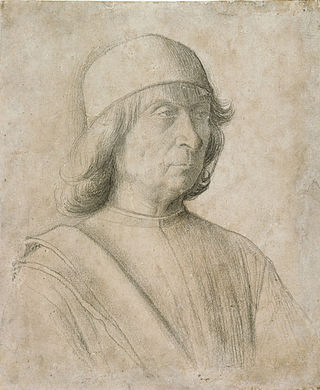
Gentile Bellini was an Italian painter of the school of Venice. He came from Venice's leading family of painters, and at least in the early part of his career was more highly regarded than his younger brother Giovanni Bellini, the reverse of the case today. From 1474 he was the official portrait artist for the Doges of Venice, and as well as his portraits he painted a number of very large subjects with multitudes of figures, especially for the Scuole Grandi of Venice, wealthy confraternities that were very important in Venetian patrician social life.

Andrea Mantegna was an Italian painter, a student of Roman archeology, and son-in-law of Jacopo Bellini.

Lorenzo Lotto was an Italian painter, draughtsman, and illustrator, traditionally placed in the Venetian school, though much of his career was spent in other north Italian cities. He painted mainly altarpieces, religious subjects and portraits. He was active during the High Renaissance and the first half of the Mannerist period, but his work maintained a generally similar High Renaissance style throughout his career, although his nervous and eccentric posings and distortions represented a transitional stage to the Florentine and Roman Mannerists.

Vittore Carpaccio (UK: /kɑːrˈpætʃ oʊ/, US: /-ˈpɑːtʃ-/, Italian: [vitˈtoːre karˈpattʃo]; was an Italian painter of the Venetian school who studied under Gentile Bellini. Carpaccio was largely influenced by the style of the early Italian Renaissance painter Antonello da Messina, as well as Early Netherlandish painting. Although often compared to his mentor Gentile Bellini, Vittore Carpaccio’s command of perspective, precise attention to architectural detail, themes of death, and use of bold color differentiated him from other Italian Renaissance artists. Many of his works display the religious themes and cross-cultural elements of art at the time; his portrayal of St. Augustine in His Study from 1502, reflects the popularity of collecting "exotic" and highly desired objects from different cultures.

BartolomeoMontagna was an Italian Renaissance painter who mainly worked in Vicenza. He also produced works in Venice, Verona, and Padua. He is most famous for his many Madonnas and his works are known for their soft figures and depiction of eccentric marble architecture. He is considered to be heavily influenced by Giovanni Bellini, in whose workshop he might have worked around 1470. Benedetto Montagna, a productive engraver, was his son and pupil and active until about 1540. He was mentioned in Vasari's Lives as a student of Andrea Mantegna but this is widely contested by art historians.

Sebastiano del Piombo was an Italian painter of the High Renaissance and early Mannerist periods famous as the only major artist of the period to combine the colouring of the Venetian school in which he was trained with the monumental forms of the Roman school. He belongs both to the painting school of his native city, Venice, where he made significant contributions before he left for Rome in 1511, and that of Rome, where he stayed for the rest of his life, and whose style he thoroughly adopted.

Marco Basaiti was a Renaissance painter who worked mainly in Venice and was a contemporary of Giovanni Bellini and Cima da Conegliano. He has been referred to by several names including Marco Baxaiti, Marcus Basitus, and Marcus Baxiti. There is little documentation on Marco Basaiti besides his painting signatures and a guild's ledger of 1530 that records him as a painter of figures.
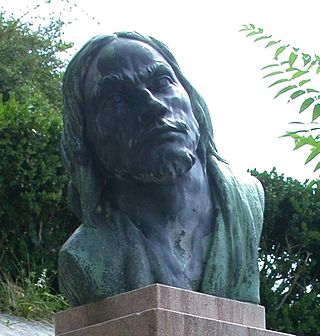
Pordenone, Il Pordenone in Italian, is the byname of Giovanni Antonio de’ Sacchis, an Italian Mannerist painter, loosely of the Venetian school. Vasari, his main biographer, wrongly identifies him as Giovanni Antonio Licinio. He painted in several cities in northern Italy "with speed, vigor, and deliberate coarseness of expression and execution—intended to shock".

San Francesco della Vigna is a Roman Catholic church in the Sestiere of Castello in Venice, northern Italy.

The Madonna dell'Orto is a church in Venice, Italy, in the sestiere of Cannaregio.

San Giovanni Grisostomo is a small church in the sestiere or neighborhood of Cannaregio, Venice.
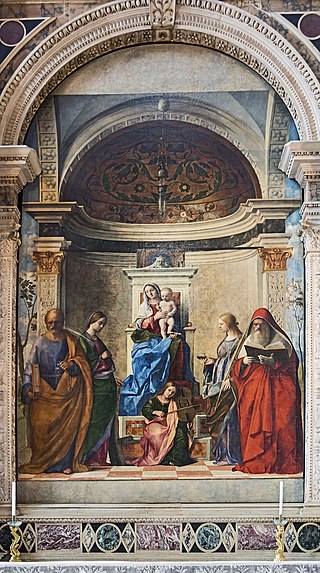
The San Zaccaria Altarpiece is a painting by the Italian Renaissance painter Giovanni Bellini, executed in 1505 and located in the church of San Zaccaria, Venice.

The San Giobbe Altarpiece is a c. 1487 oil painting by the Italian Renaissance master Giovanni Bellini. Inspired by a plague outbreak in 1485, this sacra conversazione painting is unique in that it was designed in situ with the surrounding architecture of the church, and was one of the largest sacra conversazione paintings at the time. Although it was originally located in the Church of San Giobbe, Venice, it is now housed in the Gallerie dell'Accademia in Venice after having been stolen by Napoleon Bonaparte.
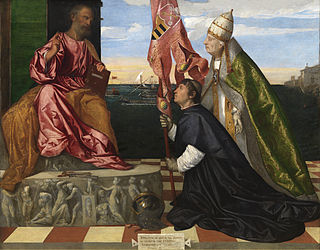
Jacopo Pesaro being presented by Pope Alexander VI to Saint Peter is an oil painting on canvas by Titian, now in the Royal Museum of Fine Arts in Antwerp.

St. Mark Preaching in Alexandria is an oil painting by Gentile and Giovanni Bellini, dated to 1504-1507, and held in the Pinacoteca di Brera, in Milan.

The Pesaro Altarpiece is an oil on panel painting by Giovanni Bellini, dated to some time between 1471 and 1483. It is considered one of Bellini's first mature works, though there are doubts on its dating and on who commissioned it. The work's technique is not only an early use of oils but also of blue smalt, a by-product of the glass industry. It had already been used in the Low Countries in Bouts' 1455 The Entombment, but this marked smalt's first use in Italian art, twenty years before Leonardo da Vinci used it in Ludovico il Moro's apartments in Milan in 1492. Bellini also uses the more traditional lapis lazuli and azurite for other blues in the work.

The Barbarigo Altarpiece or Enthroned Madonna and Child with Angel Musicians and Saint Mark, Saint Augustine and Doge Agostino Barbarigo is a 1488 oil painting on panel by Giovanni Bellini, now in the church of San Pietro Martire in Murano.
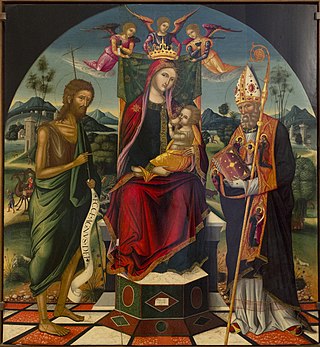
Madonna and Child enthroned with St. John the Baptist and St. Augustine is an oil painting by Greek painter Ioannis Permeniates. He was from Crete living in Venice. He was active during the first part of the 16th century. There are dozens of works attributed to the artist. He is a cross-over artist who painted in both the maniera greca and the Venetian style. Other similar artists were El Greco and Michael Damaskinos. Ioannis Permeniates's work was influenced by Vittore Carpaccio and Giovanni Bellini. His most notable painting is the Madonna and Child enthroned with St. John the Baptist and St. Augustine. Many Italian artists painted the same subject matter. The most famous painting depicting the subjects is the Madonna and Child with St John the Baptist and St Augustine by Petrus Perusinus. The Permeniates is part of the collection Museo Correr in Venice, Italy.



















